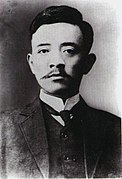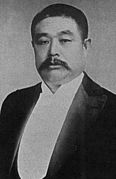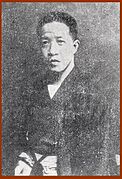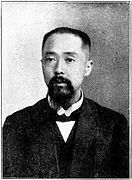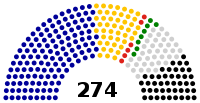
The Legislative Yuan is the unicameral legislature of the Republic of China (Taiwan) located in Taipei. The Legislative Yuan is composed of 113 members, who are directly elected for four-year terms by people of the Taiwan Area through a parallel voting system.

Song Jiaoren was a Chinese republican revolutionary, political leader and a founder of the Kuomintang (KMT). Song Jiaoren led the KMT to electoral victories in China's first democratic election. He based his appeal on the upper class gentry, landowners, and merchants. Historians have concluded that provisional president, Yuan Shikai, was responsible for his assassination on 22 March 1913.

The National Assembly was the authoritative legislative body of the Republic of China, from 1947 to 2005. Along with the Control Yuan and the Legislative Yuan, the National Assembly formed the tricameral parliament of the Republic of China.

The Constitution of the Republic of China is the fifth and current constitution of the Republic of China (ROC), ratified by the Kuomintang during the Constituent National Assembly session on 25 December 1946, in Nanking, and adopted on 25 December 1947. The constitution, along with its Additional Articles, remains effective in ROC-controlled territories.
The history of the Republic of China began in 1912 with the end of the Qing dynasty, when the Xinhai Revolution and the formation of the Republic of China put an end to 2,000 years of imperial rule. The Republic experienced many trials and tribulations after its founding which included being dominated by elements as disparate as warlord generals and foreign powers.

The Control Yuan is the supervisory and auditory branch of the government of the Republic of China, both during its time in mainland China and Taiwan.

This is a timeline of the Republic of China.
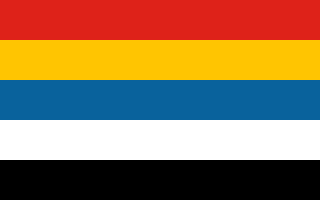
The Beiyang government was the internationally recognized government of the Republic of China between 1912 and 1928, based in Beijing. It was dominated by the generals of the Beiyang Army, giving it its name.

The Nationalist government, officially the National Government of the Republic of China, refers to the government of the Republic of China from 1 July 1925 to 20 May 1948, led by the nationalist Kuomintang (KMT) party.
The Constitutional Protection Movement was a series of movements led by Sun Yat-sen to resist the Beiyang government between 1917 and 1922, in which Sun established another government in Guangzhou as a result. It was known as the Third Revolution by the Kuomintang. The constitution that it intended to protect was the Provisional Constitution of the Republic of China. The first movement lasted from 1917 to 1920; the second from 1921 to 1922. An attempted third movement, begun in 1923, ultimately became the genesis for the Northern Expedition in 1926.
In the history of political parties in China, the first major party in China was the Kuomintang (KMT), which moved to Taiwan in 1949. It was founded in the Republic of Hawaii on November 24, 1894, before being reorganized at Guangdong Province on August 25, 1912, from a union of several revolutionary groups. The Republic of China was founded by Kuomintang's leader Sun Yat-sen later that year. In 1921, the Chinese Communist Party (CCP) was founded by Chen Duxiu and Li Dazhao in Shanghai as a study society, and an informal political network.

The Government of the Republic of China, is the national authority whose actual-controlled territory consists of main island of Taiwan (Formosa), Penghu, Kinmen, Matsu, and other island groups, collectively known as Taiwan Area or Free Area. A unitary state, the ROC government, under the current constitutional amendments, is run by a de facto semi-presidential system, consists of the presidency and five branches (Yuan): the Executive Yuan, Legislative Yuan, Judicial Yuan, Examination Yuan, and Control Yuan. The president is the head of state, with the premier as the head of government, currently ruled by the Democratic Progressive Party (DPP) since 2016. Since the 2005 amendments of the Additional Articles of the Constitution, the Legislative Yuan has been the de facto unicameral parliamentary body of the country.

The Progressive Party was a political party in the Republic of China from 1913 to 1916.
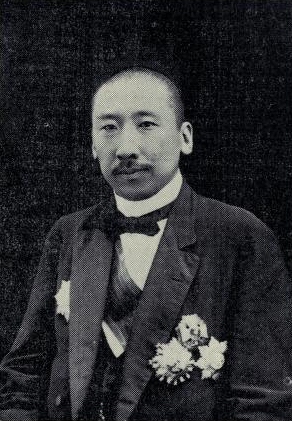
The 1918 Chinese National Assembly elections, held in May to June, were the elections for the second National Assembly. The bicameral assembly consisted of a senate and a house of representatives. Representatives were directly elected while senators were elected by provincial assemblies.

The Republic of China (ROC) began as a sovereign state in mainland China on 1 January 1912 following the 1911 Revolution, which overthrew the Manchu-led Qing dynasty and ended China's imperial history. From 1927, the Kuomintang (KMT) reunified the country and ruled it as a one-party state and made Nanjing the national capital. In 1949, the KMT-led government was defeated in the Chinese Civil War and lost control of the mainland to the Chinese Communist Party (CCP). The CCP established the People's Republic of China (PRC) while the ROC was forced to retreat to Taiwan and retains control over the "Taiwan Area"; the political status of Taiwan remains in dispute to this day.

The Republican Party was a short-lived political party in the Republican era of China from 1912 to 1913.

The Qing dynasty held its first set of provincial assembly elections from February to June 1909. Following a lengthy period of political turmoil and the failure of the 1898 Hundred Days' Reform, the constitutionalist movement gained approval from the imperial court and Empress Dowager Cixi in the aftermath of the Boxer Rebellion. Following administrative and bureaucratic reform, such as the abolition of the imperial examination system in 1905, the Qing government created the Constitutional Commission in preparation for a twelve-year transition from absolutism to a constitutional monarchy. Seeing local self-governance as a valuable initial step towards constitutionalism, the Commission received imperial approval in 1907 to create provincial assemblies.
The Second Revolution was a 1913 revolt by the governors of several southern Chinese provinces and supporters of Sun Yat-sen's Kuomintang against the Beiyang Government of the Republic of China led by Yuan Shikai. It was quickly defeated by Yuan's armies and led to the continued consolidation of Yuan's powers as President of the Republic of China.
The National Assembly was the legislative branch of the Beiyang government during the Republican era of Chinese history. The National Assembly was first founded in 1913, following the overthrow of the previous Qing dynasty, as the first free democratic legislature in Chinese history. It was disbanded less than a year later as President Yuan Shikai assumed dictatorial power and declared himself the Emperor of China. During the Warlord Era, the National Assembly was resurrected and disbanded more than once as different warlords vied for power and legitimacy.
